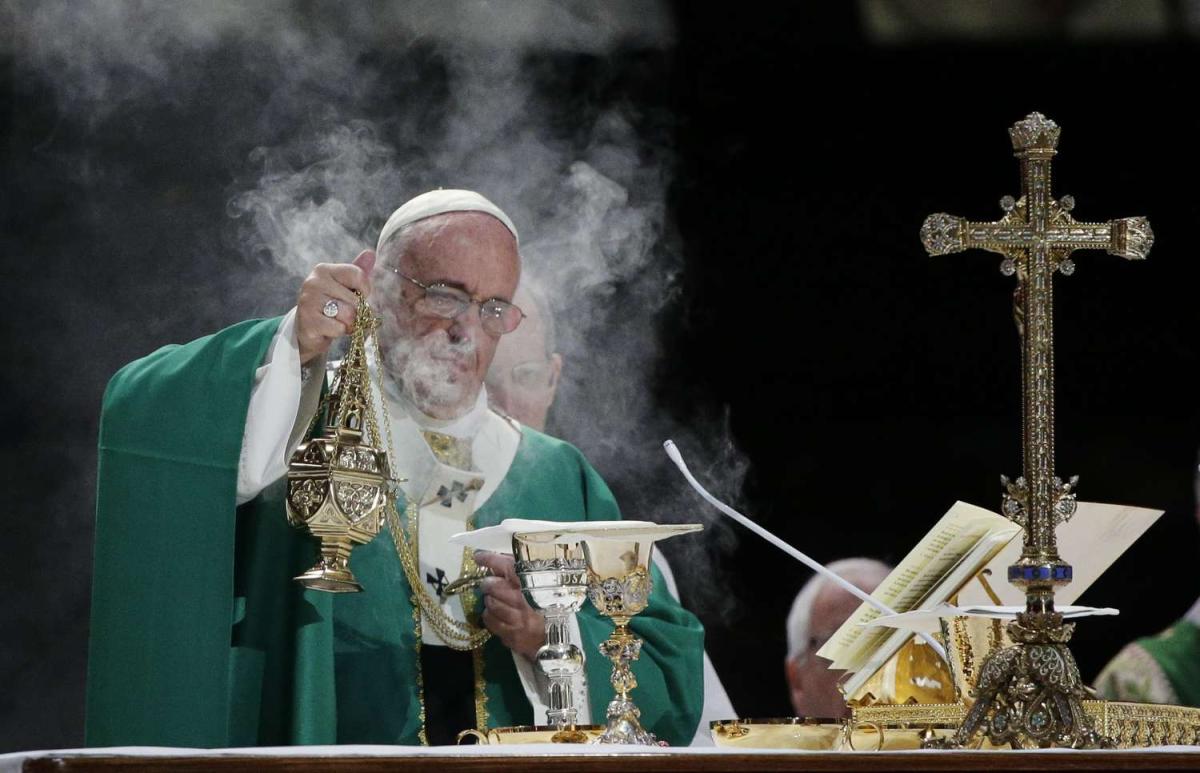
It's one of the most solemn moments of the mass: the priest dramatically raises the Eucharist above his head, the sides of that big sheet thingy he's wearing falling away to show the sleeves below. Okay, so "big sheet thingy" may not be the technical term, but I'll bet most of you can't come up with the right word. Let's change that by taking a look at the ritual vestments a priest wears during mass.
Peasant or patrician, if you were an ancient Roman you probably wore a long white shirt hanging down below your knees, knotted at the waist with a cord of some kind, with a heavier colored robe draped across it that could be pulled up over your head if the weather wasn't cooperating. The Roman toga, beloved of frat parties everywhere, is indeed the original inspiration for the sacred garments that priests wear in churches around the world today. In the 5th and 6th centuries, clothing styles began to change, but most people -- and especially celebrants -- kept wearing their Sunday best to Sunday mass. So even when people weren't traipsing around in togas during the week, the priest was usually still in something like it come Sunday morning.
Priestly styles change too, though, and over time the two simple garments developed into a whole panoply of ritual vestments, each with a symbolic meaning. Amice, alb, cincture, stole, chasuble -- that's more layers than a Southerner prepping for a Minnesota winter, and it doesn't even include other potential additions, like the cope. Ready to dive in? Okay, let's go.
The amice is a small rectangular cloth with strings hanging down from it. Nowadays the priest touches it to his head before letting it fall to his shoulders, but it used to be more like a napkin the priest would lay over his head to protect his coiffure while he put on the rest of the robes. That's probably how it picked up its current symbolism of the "helmet of salvation."
The alb goes on next. It's the long straight tunic, usually white, that was the original Roman undergarment. You don't have to work hard to see the symbolism of purity and chastity here.
The cincture is a belt that goes over the alb. Originally it just helped keep everything in place, but priestly celibacy gets a second push here as the priest specifically prays to be girded with the girdle of purity as he puts it on.
Next up we've got the stole, a piece of cloth that goes around the priest's neck and hangs evenly down the front of the body -- imagine draping a table runner around your neck and you'll get the visual. It represents the priest's authority to teach and celebrate the liturgy.
Finally we come to the big sheet thingy, the chasuble, a word that comes from the Latin for "little house" -- I you not. When you think of a priest's ritual garb, most likely it's the chasuble that comes to mind since it's the one on top and usually colorfully decorated. The chasuble was the Roman outer garment, but in the Catholic version it crept up over both shoulders and eventually the sides got snipped so that the priest could have more range of arm movement. Symbolically it is supposed to represent the charity of Christ, which covers all things.
All this stuff is worn by priests, but deacons get decked out, too. They wear albs, cinctures, and stoles, but instead of the priest's chasuble they get their very own dalmatic, which is the long drapey cloth they wear across one shoulder. Named for the peasant garb of Dalmatia (yeah, that's surprising), the dalmatic used to be worn exclusively by popes. My, how things change.
This is far from an exhaustive list of the ritual vestments worn by priests, bishops, and other members of the Church's hierarchy, but it's what you're likely to see at your regular weekly mass. Catholics aren't alone among Christians in using ritual vestments -- some Protestant groups have ritual attire, and Orthodox Christians have an array of vestments that makes the Catholic list look puny.
As a result of Vatican II the Church reached back into the earliest centuries of Christian history for a deeper understanding of how many of the rituals and practices of Catholic life came about. Earlier meanings have been reclaimed and renewed, and this has led to some changes in the priestly vestments. Still, I don't think we're likely to see priests wearing Roman togas around the sanctuary anytime soon. At least I hope not.
Read earlier installments of "Catholics Do This but They Don't Do That":
#1 - Pray the Rosary
#2 - Make the Sign of the Cross
#3 - Genuflect
#4 - Confession
Want to know about a particular Catholic practice? Ask Catholics Do This But They Don't Do That in the comment section below and watch for your topic to show up in weeks to come.
9/29/2009 4:00:00 AM




